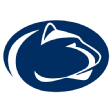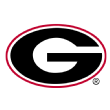Saquon Barkley, who is perhaps the most hyped running back prospect since Reggie Bush, arrives at an interesting point in NFL history. The running back is no longer a "premier" position in the draft -- NFL teams would much rather use a high pick on a quarterback, offensive tackle, pass-rusher, or wide receiver.
Proponents of advanced statistics have been at the forefront of this change of thinking, pointing out that running backs often have short careers and are usually replaced with ease.
Accordingly, any team willing to go against this trend and use a high pick on Barkley should be fairly certain that he is likely to live up to his hype. Enter BackCAST, which is Football Outsiders' metric for projecting the likelihood of success for running back prospects in the NFL draft.
Historically, a college running back with a good size-speed combination, a high average yards per carry, and who represented a large percentage of his college team's running attack is more likely to succeed at the NFL level. BackCAST considers these factors and projects the degree to which the running back will exceed the NFL production of an "average" drafted running back during his first five years in the NFL. For example, a running back with a plus-50 percent BackCAST is projected to gain 50 percent more yards than the "average" drafted running back. BackCAST also projects whether each running back is likely to be heavily involved in the receiving game or is more of a "ground-and-pound" back.
We have run BackCAST for all of this year's top prospects, and there is a huge gap between No. 1 and the rest of the group. This draft is also a weak one for receiving running backs -- with one notable exception.
Would it surprise you to learn that the top prospect and the top receiving back are both Saquon Barkley?
For more detail on how BackCAST works, check out the bottom of the article. What follows is a ranking of the top running back prospects for 2018 according to our model:

Saquon Barkley, Penn State Nittany Lions
BackCAST score: plus-181.9 percent
Type of back: Receiving
Similar historical prospects: Ricky Williams, LaDainian Tomlinson
You can believe the hype: Barkley has a massive BackCAST projection. In fact, he has the second highest projection of any running back in BackCAST's dataset, and he is a relatively close second to Ricky Willliams' best ever plus-190.1 percent projection.
Barkley's historically great projection is primarily driven by his great size-speed combination. Barkley is the heaviest running back in BackCAST's dataset to run a 40-yard dash in 4.40 seconds or better.
Moreover, Barkley is not just a workout warrior. Penn State gave Barkley 42.8 percent of its rushing attempts when he was only a freshman and gave him more than 50 percent of its rushing attempts each year thereafter. Nobody knows a player's talents as well as his coaches, who see the player's performance in practice as well as on game day. Any competent coach (as well as most of the incompetent ones) will try to get supremely talented players the ball. Barkley's coaches gave him the ball a lot, and history shows that Barkley's coaches' vote of confidence is an excellent sign for his potential success.
The weakest aspect of Barkley's projection is his yards per attempt. Barkley averaged 5.73 yards per attempt, which is above average. It is just not stratospherically above average like the rest of his metrics. To top it off, Barkley is also likely to be effective catching passes out of the backfield.
Barkley's numbers don't nullify all the analytics that caution against using a high first-round pick on a running back. And despite all of these positive indicators, there's always the slim chance that he could bust. However, it is hard to imagine a much better prospect at the running back position than Saquon Barkley.

Royce Freeman, Oregon Ducks
BackCAST score: plus-88.1 percent
Type of back: Balanced
Similar historical prospects: Michael Turner, Kevin Jones
In last year's draft, BackCAST had three very good prospects that it rated relatively close together: Leonard Fournette, Dalvin Cook and Joe Mixon. This year, there is a huge gap between Barkley and BackCAST's second-rated prospect, Freeman. That said, Freeman is actually a pretty nice prospect who may be severely underrated as a mid-round pick.
A good all-around prospect, Freeman received relatively heavy usage at Oregon, he has a good size-speed combination, and he had a better yards-per-attempt average than Barkley.

Derrius Guice, LSU Tigers
BackCAST score: plus-86.8 percent
Type of back: Ground-and-pound
Similar historical prospects: Jamal Lewis, Rashard Mendenhall
Guice is appropriately rated as a first- to second-round pick. He had a relatively heavy workload during college, especially considering that he had to compete with future top-five pick Leonard Fournette for carries up through 2017. Guice also did a lot with those opportunities -- he averaged 6.4 yards per attempt, which is one of the best marks of this draft class.
The downside to Guice is that he is unlikely to give his team much in the receiving game. He averaged just more than seven receiving yards per game and is a larger than average back, which are both bad signs for his receiving prospects in the NFL.

Rashaad Penny, San Diego State Aztecs
BackCAST score: plus-81.0 percent
Type of back: Balanced/Ground-and-pound
Similar historical prospects: Melvin Gordon, Tevin Coleman
Aside from Barkley, Penny may be the most intriguing prospect in this year's draft from a BackCAST perspective. Penny averaged a phenomenal adjusted 7.37 yards per attempt, which is the second highest score all time in BackCAST's database. Penny also has a good size-speed combination -- he is a big back at 222 pounds, but he has the speed of a running back 20 pounds lighter (4.46-second 40-yard dash).
Penny's projection takes a big hit, however, because his workload was comparatively light. In fact, he has the largest disparity between adjusted yards per attempt and college workload in BackCAST's dataset. Until his senior year, Penny was stuck behind other running backs on the depth chart; most notably, current Philadelphia Eagles running back Donnel Pumphrey.
There is some evidence that San Diego State's coaches may have simply been mistaken about who was the better running back. Every year he played, Penny beat every other running back on the roster in yards per attempt. In particular, he averaged over a yard per carry more than Pumphrey as a junior. In fact, if you follow the running back rotation at San Diego State closely, it appears that the coaches gave a lot of weight to experience (San Diego State also diverted carries to senior running back Christian Price during Penny's sophomore year). If that is the case, then Penny may be much more talented than his college workload suggests.
In sum, Penny's BackCAST projection is good, and there is significant reason to believe that the one negative aspect of his profile does not reflect his true ability.

Ronald Jones II, USC Trojans
BackCAST score: plus-60.0 percent
Type of back: Balanced
Similar historical prospects: Laurence Maroney, Jordan Howard
Ronald Jones had a reasonably heavy workload at USC. As a junior, Jones accounted for 52 percent of his team's carries, while the average drafted running back only accounts for 36.5 percent of his team's carries as a junior. Jones was also explosive when he touched the football, averaging more than 6 yards per carry.
Jones is a bit of an odd case, however, because he is a smaller back and he never was much of receiver out of the backfield in college.

Nick Chubb, Georgia Bulldogs
BackCAST score: plus-76.2 percent
Type of back: Ground-and-pound
Similar historical prospects: Jonathan Stewart, Ahman Green
Sony Michel, Georgia Bulldogs
BackCAST score: plus-16.8 percent
Type of back: Balanced
Similar historical prospects: Ryan Williams, Shane Vereen
Chubb and Michel shared the same backfield at Georgia, and so it makes sense to consider the two running backs together. Scouts Inc. values Michel as a first- to second-rounder, and Chubb as a second- to third-rounder. BackCAST, however, thinks that Chubb is a far superior prospect, as he outperformed Michel on all of BackCAST's metrics.
Chubb shouldered a much larger share of the workload than Michel, and there is no reason to believe that any unusual circumstance caused Chubb to get more attempts than Michel. In fact, the disparity would have been even larger if Chubb had not missed the second half of the 2015 season due to a knee injury. Georgia's coaches, who saw Chubb and Michel in practice every day, clearly preferred Chubb. Michel did not get within 60 carries of Chubb's totals in any year when Chubb was completely healthy. Chubb was also more productive on a per-carry basis.
Chubb is also bigger and faster than Michel: Chubb has a 13-pound advantage and had a slightly better 40-yard dash time (4.52 seconds versus 4.54 seconds).
Methodology
BackCAST is based on a statistical analysis of all of the Division I halfbacks drafted in the years 1998-2016, and measures the following:
The prospect's weight at the NFL combine
The prospect's 40-yard dash at the NFL combine. If he did not run at the combine, BackCAST uses his pro day time
The prospect's yards per attempt with an adjustment for running backs that had fewer career carries than an average drafted running back
The prospect's "AOEPS," which measures how much, on average, the prospect's team used him in the running game during his career relative to the usage of an average drafted running back during the same year of eligibility
The prospect's receiving yards per game in his college career
